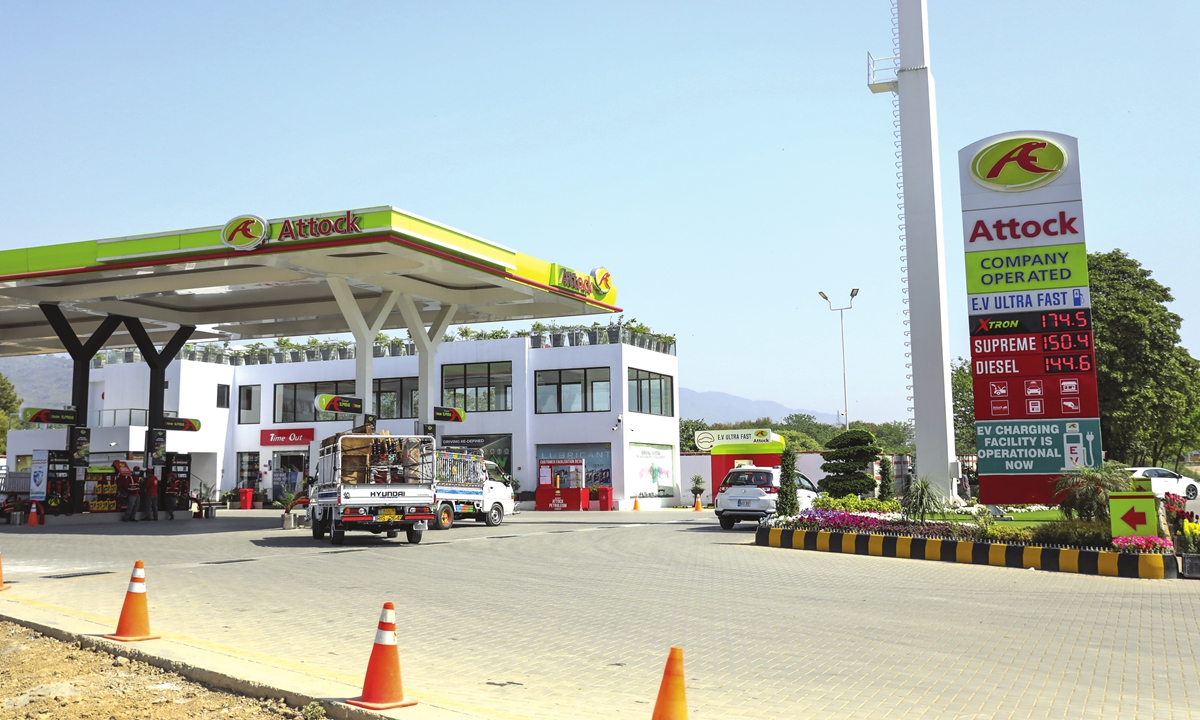US’ financial tightening places pressure on developing economies in Asia
Debt crises brewing in lower-income nations

An Attock Petroleum gas station in Islamabad, Pakistan,on April 2, 2022.Photo: VCG
Editor's Note: The US' earlier-than-expected financial tightening has rippled across Asia, prompting central banks from developing economies in Asia to hike interest rates to contain the outflow of capital and prevent the depreciation of local currencies. However, they face the risk of triggering domestic recessions, while lower-income countries like Laos strain under the pressure of growing debt. This is the final article of a multi-part series on the US' exporting of economic crises to the world.
The US has rapidly reversed its ultra-loose monetary policies put in place during the pandemic by intensifying super-sized interest rate tightening and shrinking its portfolio of bond holdings, presenting a clear and present danger for emerging Asian economies which rely on openness of trade and finance, with a debt crisis brewing in fragile economies such as Laos.
The adverse spillover effects of the US-driven global interest rate hikes have begun to emerge, with Sri Lanka and Pakistan already mired in their own economic and debt crisis, while some economies which have been performing well, such as Vietnam and India, forced to downgrade growth forecasts and raise interest rates, Liu Xiaoxue, an associate research fellow at the National Institute of International Strategy under the Chinese Academy of Social Sciences, told the Global Times on Monday.
Many developing countries in Asia are importers of oil and gas, and thus the soaring international commodity prices have pushed up local inflationary pressure, especially in lower-income countries where they make up a large share of consumer expenditure, according to Liu, who also said that countries with a less diversified economic structure are vulnerable and may tumble into a current-account balance crisis.
On the day the US Federal Reserve announced an interest rate hike of 75 basis points (bps), Western media reported that landlocked Laos, facing spiraling inflation, acute fuel shortages and declining cash reserves, was under serious financial strain, similar to that which has threatened Pakistan's balance of payments.
Moody's Investor Service recently downgraded Laos' sovereign debt rating one notch further into non-investment grade, the Financial Times reported.
It said that the country's default risk would "remain high given very weak governance, a very high debt burden and insufficient coverage of external debt maturities" by foreign exchange reserves.
The financial conditions in the US are of particular significance for developing countries in Asia, especially those that rely more on short term capital flows. In this regard, some Asian countries have been forced to follow the US in conducting premature financial tightening so as to contain the risk of capital outflows, placing their own domestic economic growth at risk.
In May, Malaysia's central bank unexpectedly raised its benchmark interest rates to 2 percent from an historical low of 1.75 percent where it has been adopted since July 2020. Pakistan's central bank abruptly hiked interest rates by 250 bps following an emergency meeting in April, while the Philippine central bank raised interest rates for the first time since 2018 in May by 25 bps, as economists forecast that inflation rate in the country could be higher than 2022 target.
A monetary policy shock in the US, assumed to increase interest rates by at least 25 bps, is likely to hurt growth in developing Asian economies, by as much as 0.4 percentage points in Malaysia, to 0.7 percentage points in Thailand, according to a report by the World Bank in April.
In spite of remarkable macro-economic figures so far this year as the pandemic recedes, India is now under monumental pressure from surging inflation and higher oil prices, while also showing signs that capital outflows from the third-largest economy in Asia are accelerating, Lou Chunhao, a deputy director of the Institute of South Asian Studies at the China Institutes of Contemporary International Relations, told the Global Times on Tuesday.
"The Indian government has put containing inflation in a priority position over economic growth," he said. The country with a 1.4 billion population imports more than 80 percent of its crude oil, and is also the world's largest importer of edible oils, according to media reports.
Measures to limit pain
It's worth noting that compared with drastic inflation in some developed economies such as the US and the EU, the inflation rate in most of Asia's emerging and developing economies remains controllable. For example, Indonesia saw its CPI rise by 3.55 percent year-on-year in May, the highest since December 2017, but it's less than half of the 8.1 percent in the EU.
Meanwhile, the currencies of countries like Indonesia, Thailand and India have depreciated by around 3-5 percent against the US dollar so far in 2022, remaining firm in the global foreign exchange market.
The Thailand government has talked operators of oil and gas refineries into contributing up to 8 billion baht ($226 million) per month from July to September to the Oil Fuel Fund to ease the impact of rising fuel prices and inflation met with the country's gas and oil refineries. In addition, the government agreed to a tax incentive to boost the vital tourism sector, according to local media outlet the Nation Thailand.
The World Bank has suggested governments in the region provide targeted support to households and small businesses so as to limit pain from the shocks and create space for growth-enhancing investment. Meanwhile, they are encouraged to engage in the reform of trade-related policies in goods and services to take advantage of shifts in the global trade landscape, while boosting competition to incentivize the adoption of new digital technologies.

